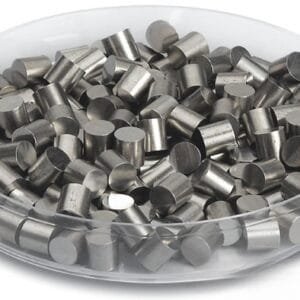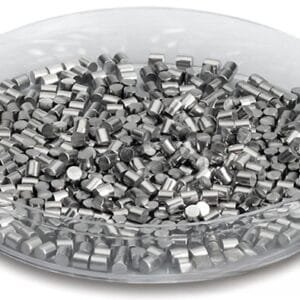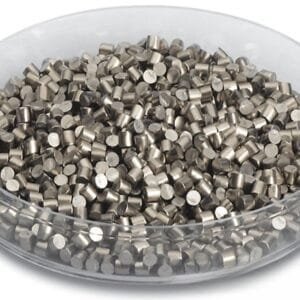| Material Type | Gallium Telluride |
| Symbol | GaTe |
| Color/Appearance | black pieces |
| Melting Point (°C) | 824 |
| Theoretical Density (g/cc) | 5.44 |
| Z Ratio | – |
| E-Beam | – |
| Thermal Evaporation Techniques | Boat: – Crucible: – |
| E-Beam Crucible Liner Material | – |
| Temp. (°C) for Given Vap. Press. (Torr) | – |
| Comments | – |
Gallium Telluride Pellet Evaporation Material
TFM offers high-purity Gallium Telluride Pellet Evaporation Material, specifically engineered for thin-film deposition in semiconductor, optoelectronic, and infrared applications. Composed of gallium (Ga) and tellurium (Te), this material is widely used in infrared detectors, thermoelectric devices, and advanced photonic applications. Gallium telluride (Ga2Te3) exhibits excellent semiconducting properties, making it a key material for infrared optics, quantum electronics, and next-generation photovoltaic technologies.
This material is designed for thermal evaporation and electron beam (E-beam) evaporation, ensuring uniform film thickness, high purity, and strong adhesion to substrates, making it ideal for cutting-edge research and industrial applications.
Key Features and Advantages
High Infrared Absorption: Ideal for infrared detection and imaging applications, enhancing sensor sensitivity.
Superior Thermoelectric Properties: Supports high-efficiency thermoelectric materials, essential for power generation and cooling systems.
Excellent Semiconductor Characteristics: Features a direct bandgap, making it suitable for optoelectronic devices such as lasers, LEDs, and photodetectors.
High Purity & Precise Deposition: Ensures uniform thin-film coatings, minimizing defects and improving device performance.
Customizable Composition: TFM offers tailored specifications to meet the specific needs of advanced research and industrial applications.
Applications
Infrared Sensors & Imaging: Gallium telluride is used in infrared imaging systems, night vision technology, and thermal sensors for military, medical, and industrial applications.
Thermoelectric Devices: Applied in high-performance thermoelectric materials, enabling energy conversion for cooling systems and power generation.
Optoelectronics & Photonics: Utilized in photodetectors, laser diodes, and infrared photonic devices, essential for fiber optics and telecommunication systems.
Semiconductor Research: Plays a crucial role in emerging semiconductor technologies, supporting next-generation electronic components.
Thin-Film Deposition: Ensures high-quality coatings for specialized optical and electronic applications, offering superior performance and stability.
Industry Impact and Customization
TFM’s Gallium Telluride Pellet Evaporation Material is a vital component in infrared sensing, optoelectronic devices, and semiconductor research. With high purity, precise deposition control, and customizable compositions, TFM ensures its materials meet the demanding needs of cutting-edge research and industrial manufacturing.
By providing excellent semiconductor properties, superior thermoelectric performance, and high infrared absorption, TFM’s Gallium Telluride Pellet Evaporation Material is an essential material for advancing infrared technology, energy-efficient thermoelectric systems, and high-performance optoelectronic applications.


 MSDS File
MSDS File



Reviews
There are no reviews yet.